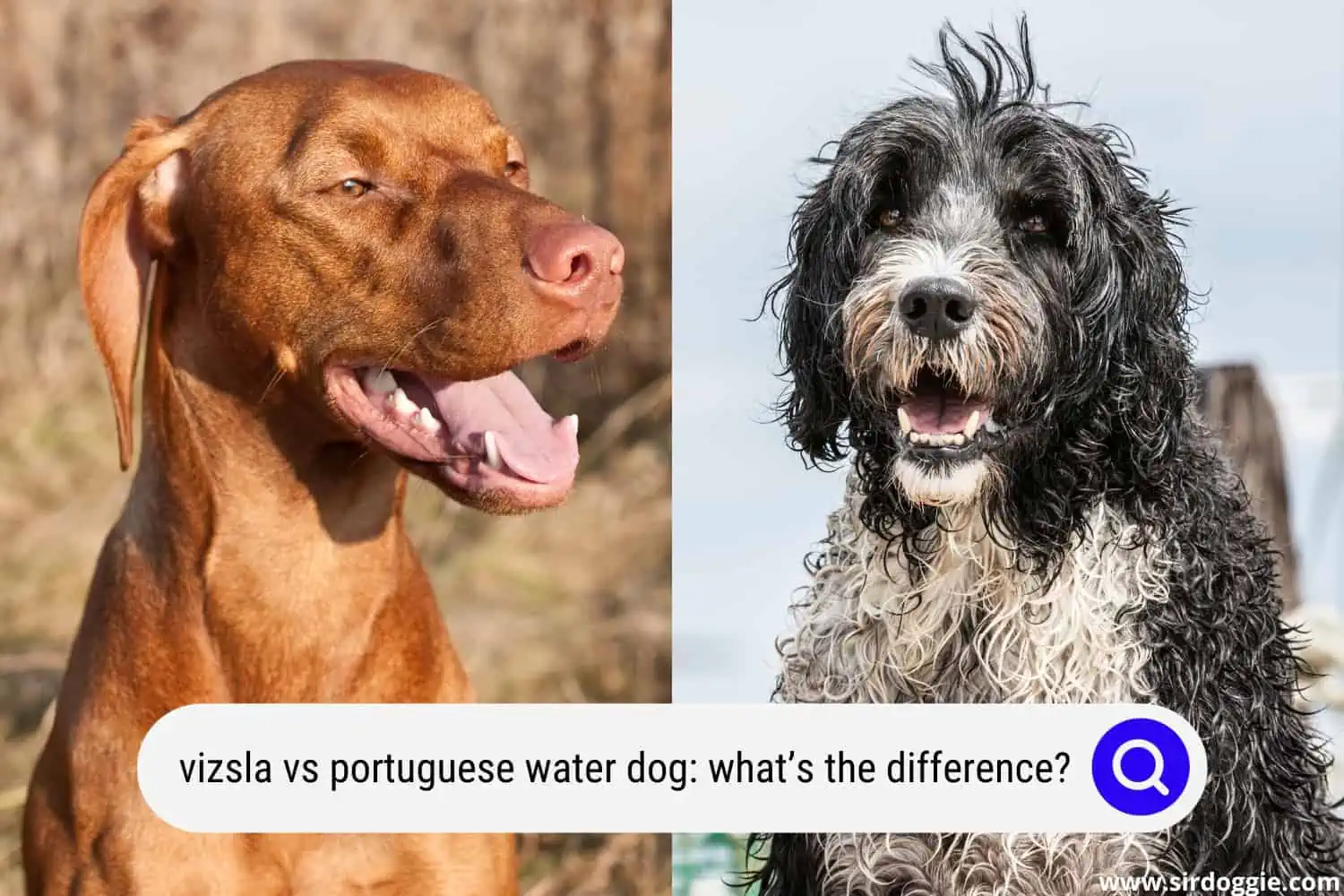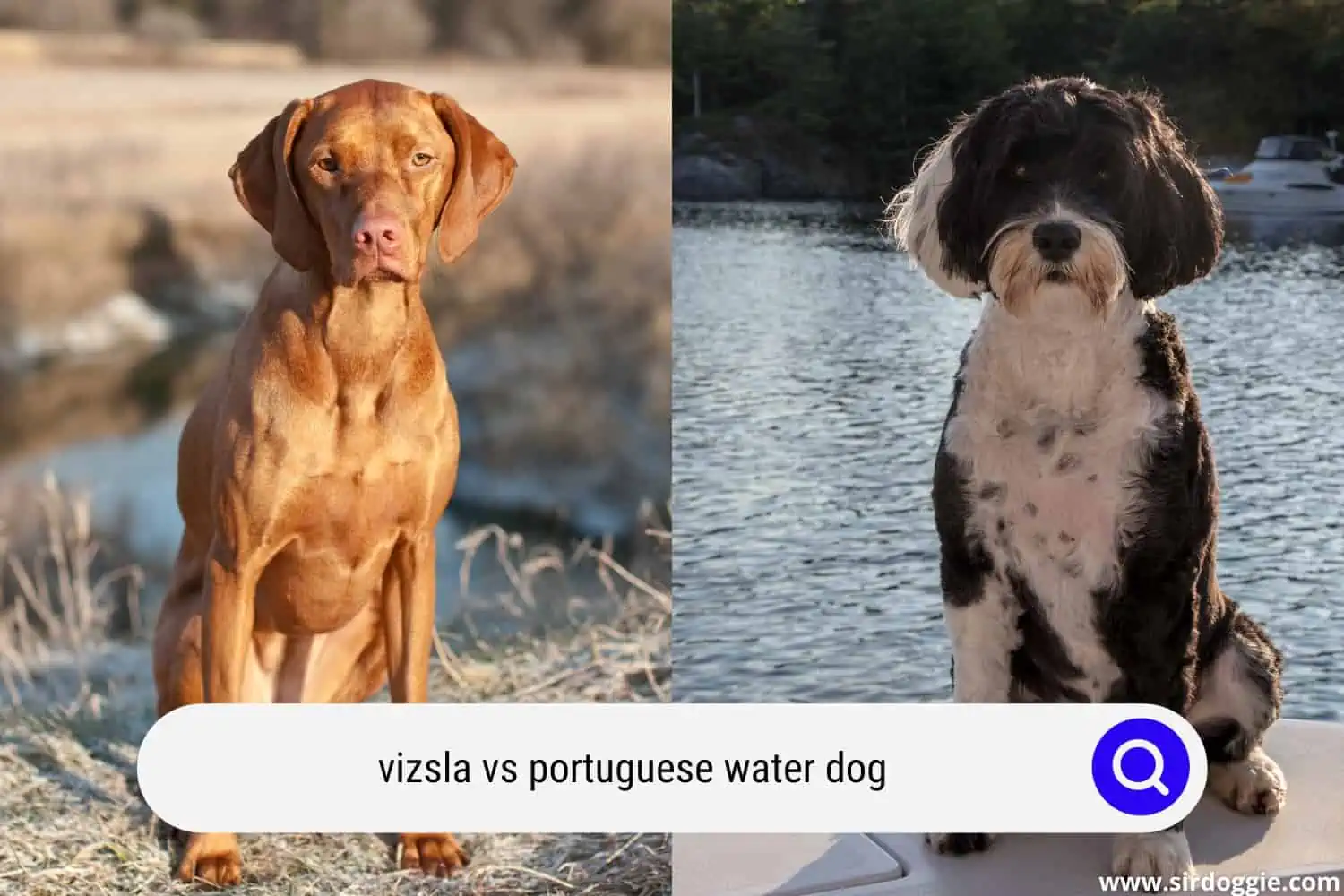Vizsla vs Portuguese Water Dog What’s the Difference
On paper, it’s obvious that the Vizsla is a bigger dog than the Portuguese water dog, even though the former is considered the smallest breed in the world of pointing dogs. However, there’s a lot more to these two special dog breeds than height, weight, wiry, curly, short, and smooth furs.

While the Vizsla is a versatile hunting dog that is very good as a family dog, the Portuguese Water Dog is a good companion dog, that can also serve as a guard and hunting dog.
So, both are versatile dogs with each possessing special qualities, different characters, and characteristics. So, which one should you choose? The Vizsla or the Portuguese Water Dog? In this Vizsla vs Portuguese Water Dog comparison article, we will lay bare the characteristics of the two dogs so you can decide which would be the best for you.
Related Reading: Vizsla vs Coyote: All You Need to Know
Vizsla: the versatile dog breed from Hungary
Originally from Hungary, the Vizsla is also known as the Hungarian Pointer. There are two types of Vizslas: the Hungarian wirehaired pointer or the wirehaired Vizsla and the Hungarian shorthaired pointer or the shorthaired Vizslas.
Regardless of the type of hair they sport, the Vizsla is an excellent versatile hunting dog that is equally great in the plains, in the undergrowth, as well as in the water.
Like a water dog, the wirehaired pointer excels in working in water, especially when it’s trained to do this at a young age. Its thick coat allows it to be more comfortable than the Hungarian Shorthaired Pointer on rough terrain.
Its hair also allows it to withstand great climatic variations very well. The shorthaired pointer is more beautiful than the wirehaired. Enduring and fast, the Hungarian Pointer is built to cover a lot of ground quickly.
History and origin of the Vizsla: the relics of the world wars
The Vizsla is a breed selected several centuries ago. In the Carpathians, sculptures dating from the 10th century have been discovered, depicting a Magyar nomad hunting with a hawk and a dog that strongly resembles a Vizsla.
After the two world wars, the breed was almost extinct and only a breeding program with Vizslas smuggled out of Hungary helped prevent their extinction. Today, the Vizsla is not only a popular hunting and retrieving dog. It is also a highly valued companion.
The Hungarian Wirehaired Pointer was born in the 1930s. It is the result of a cross between the modern Hungarian Pointer and the German Wirehaired Pointing Dog.
Vizsla Physical appearance
The Vizla is a sturdy, medium-sized dog that radiates nobility. In adulthood, males and females measure 57-64 cm and 53-60 cm respectively. They weigh between 20 and 30 kg. Their coat is short, smooth, and dense. The wheaten/golden color catches the eye.
The Hungarian Pointer is a slender, athletic, light, and elegant dog. it is very enduring and its gallop is very sustained. Lively and light on its feet, it is capable of dazzling acceleration. They are said to be faster than coyotes.
The coat is tawny and shiny. The coat is short, dense, and smooth, but also somewhat oily. It requires little maintenance: a weekly brushing is sufficient.
The eyes are brown in harmony with the coat. The body is slender and muscular The muzzle is strong and square while the ears are wide and of medium length.
The character of the gentle and intelligent Vizsla dog
An intelligent, gentle, sociable, and obedient dog, the Hungarian Pointer or Vizla is in addition to being an excellent hunter, a formidable family dog, that is always close to its masters and attentive to them. It needs to be surrounded by its loved ones and to feel loved.
The Hungarian Pointer is a hunting dog with boundless energy. It needs exercise for its well-being. If you don’t have room for it to work out or the time to put it to work, the Hungarian Pointer may not be the breed for you.
The uniqueness of the Vizsla makes it a lively, fun, and loving companion for those able to give it the time and attention it deserves. Sensitive, it enjoys being active, and learning new things, as long as it is having fun and being rewarded. It is naturally protective of those it loves.
The Vizsla needs at least two hours of physical activity per day. Like most retrievers, they love to pick up and bring back an object (on land or in water). Versatile, it can also participate brilliantly in many dog sports.
Vizsla Health
The Vizsla generally enjoys good health. However, swallowing disorders, epilepsy, and hip dysplasia are conditions more specifically linked to this breed.
The Portuguese Water Dog: the friend of the fisherman
The Portuguese Water Dog, originally from the Algarve region (located in the south of Portugal), has always been a friend of fishermen. It provides them with a multitude of fishing services but it also defends their boats and protects their property!
History and Origin of The Portuguese Water Dog
The Portuguese Water Dog, known as Cão de Agua Portugues, is a very old breed, originating in the Portuguese region of the Algarve. Coming from the Middle Ages, it is the result of crosses between various local breeds and the Barbet, a French water dog.
These dogs were in history used as messengers between the boat and the shore, to stand guard on the pontoon, and to help the fishermen gather their fish. They were moreover considered as full members of the crew. The dogs were also used for rabbit hunting.
Still not very widespread outside Portugal a century ago, the breed was not discovered in the United States until the late sixties.
Physical appearance of The Portuguese Water Dog
A medium-sized dog, its body is particularly robust and muscular thanks to the swimming exercises it performs as a fishing dog. The base of its tail is thick and tapers to the end.
Like the Vizslas, there are two varieties, one is long-haired and wavy while the other is shorter-haired and frizzy. The coat is a mostly solid color, black, brown, white, or two-tone, black or brown with white.
The Portuguese Water Dog comes in two different types of coats. Regardless of the type of coat, this dog requires regular maintenance. If you want to present it use it as a family dog and take it out on outings frequently, you will need to groom and trim your dog regularly.
Many companion dogs are shaved all over the body, which gives them a youthful appearance. When purchasing, the breeder can advise you on grooming your dog. Otherwise, you can call on a professional groomer but you have to plan for the additional expenses that this entails.
Character of the The Portuguese Water Dog
Versatile dog in and out of the water, the Portuguese Water Dog is an active, fiery, energetic dog with exceptional intelligence. An extraordinary diver and swimmer, it is a working dog who likes to help himself and who will therefore prove to be very resistant to fatigue.
Towards its master, it will be obedient, loyal, and very attentive to the work given to it. If its master is fishing, the Portuguese Water Dog will spontaneously dive into the sea to bring back any escaped fish and will do the same if a fishing net is torn. Because of its stubborn character, it will need firm but gentle training.
Calm but active, the Portuguese Water Dog is courageous and learns quickly. Loyal and very alert, it is also suitable for use as a watchdog. Although it can be stubborn if it is not properly motivated, it generally obeys its masters.
Health of The Portuguese Water Dog
Like many breeds, this dog has a few hereditary issues such as hip dysplasia, and eye disorders. Therefore, it is important to have the dog’s eyes and hips examined before breeding it. Also, it is advisable to make it pass a genetic test for rare heart disease.
Comparison Table: Vizsla vs Portuguese Water Dog
| Vizsla | Portuguese water dog | |
| Other names | Hungarian Vizsla, Hungarian Pointer, Magyar Vizsla, Drotszoru Magyar Vizsla | Cão de água português, dog of the water |
| Weight | 20 to 29 kg in males; 18 to 25 kg in females | 16 to 23 kg in females; 19 to 27 kg in males. |
| Height | 56 to 64 cm in males, 53 to 61 cm in females | 43 to 52 cm in females; 50 to 57 cm in males |
| Hypoallergenic | No | Yes |
| Life expectancy | 12 to 15 years | 12 to 15 years |
| Temperament | Loyal, Energetic, Quiet, Gentle, and Affectionate | Impetuous, Docile, Obedient, Intelligent, Quarrelsome, Brave |
| Colors | Golden, Golden Rust, Red Golden | Black, White, Brown, Black and White, White and Chocolate |
| Use | sporting and hunting dogs and loyal companions | sporting, fish herding, and companion dogs |
| Price | $1,500 to $2,200 | $2,000 to $10,000 |

Conclusion
Aside from the size, where the Vizsla appears to be bigger, the Vizslas and the Portuguese water dog are two similar dogs. Both have shorthaired and wirehaired breeds. Both are versatile, and good as hunting, companion, and water dogs; but, obviously, the Portuguese Water Dog is more inclined to water games, water activities, and all sorts.
The Vizla is a sturdy, medium-sized dog who radiates nobility. Their coat is short, smooth, and dense. The Portuguese Water Dog is also a medium-sized dog with a rectangular and muscular figure.
While both are generally expensive dogs, the Portuguese Water Dog is more expensive and some breeders can put a price tag of up to $10,000. They are expensive because of the numerous tests that must be carried out on them as they usually have health issues.

Family Dog Expert Author
Hi there! I’m Stuart, a devoted dog lover and family dog expert with over a decade of experience working with our furry companions. My passion for dogs drives me to share my knowledge and expertise, helping families build strong, loving bonds with their four-legged friends. When I’m not writing for SirDoggie, you’ll find me hiking, playing with my beautiful dog, or studying music.